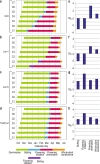Synchronisation of Arabidopsis flowering time and whole-plant senescence in seasonal environments
- PMID: 29980723
- PMCID: PMC6035182
- DOI: 10.1038/s41598-018-28580-x
Synchronisation of Arabidopsis flowering time and whole-plant senescence in seasonal environments
Abstract
Synchronisation of flowering phenology has often been observed between individuals within plant species. We expected that a critical role of flowering-time control under natural conditions is a phenological synchronisation. However, no studies have quantified the level of synchronisation of reproductive timing relative to germination timing under natural conditions. In a sequential seeding experiment (SSE) in which we manipulated the germination timing of Arabidopsis thaliana accessions, we developed a quantification index to evaluate reproductive synchrony in annual plants. In the SSE, we identified a novel phenomenon of reproductive synchrony: senescence synchrony. The role of vernalisation in realising flowering synchrony between plants of different ages under natural conditions was demonstrated by synchronisation and de-synchronisation of flowering initiation in vernalisation-sensitive and less-vernalisation-sensitive accessions, respectively. We also observed up-regulation of senescence-related genes at corresponding times. The approach we developed in this study provides a set of concepts and procedures that can be used to study reproductive synchrony experimentally under natural conditions.
Conflict of interest statement
The authors declare no competing interests.
Figures




References
-
- Augspurger CK. Reproductive synchrony of a tropical shrub: experimental studies on effects of pollinators and seed predation on Hybanthus pruinifolius (Violaceae) Ecology. 1981;62:775–788. doi: 10.2307/1937745. - DOI
-
- Findlay CS, Cooke F. Synchrony in the lesser snow goose (Anser caerulescens caerulescens). II. The adaptive value of reproductive synchrony. Evolution. 1982;36:786–799. - PubMed
-
- Kudoh, H. & Nagano, A. J. Memory of temperature in the seasonal control of flowering time: an unexplored link between meteorology and molecular biology. In Evolutionary Biology: Exobiology and Evolutionary Mechanisms (ed. Pontarotti, P.) 195–215 (Springer, 2013).
Publication types
MeSH terms
Grants and funding
LinkOut - more resources
Full Text Sources
Other Literature Sources

